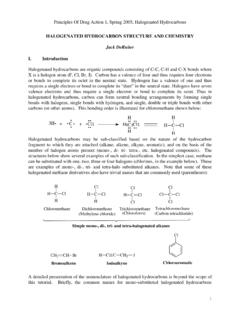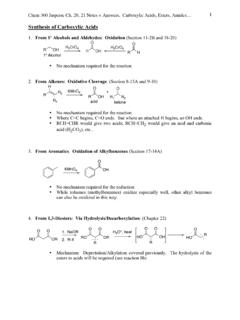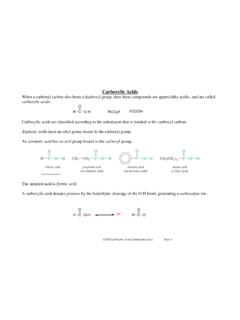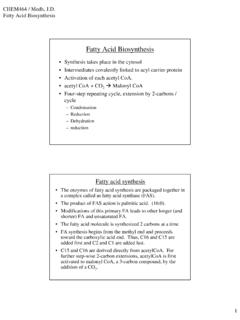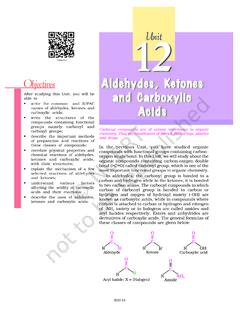Transcription of AMIDES AND RELATED FUNCTIONAL GROUPS
1 Principles of Drug Action 1, Spring 2005, Amides1 AMIDES AND RELATED FUNCTIONAL GROUPSJack DeRuiterI. IntroductionRecall that nitrogen has five valence electrons and therefore requires three electrons or bonds tocomplete its octet (see Amine Tutorial). Based on this valence and bonding order, nitrogen formsthree bonds in its neutral state and maintains one pair of non-bonded electrons (NBEs). In amidesone of the three bonds is a carbonyl carbon. Thus AMIDES may be viewed as "acylated amines" or asderivatives of carboxylic acids in which the -OH of the acid has been replaced by -NR2 where R=H, alkyl, aryl, etc.):Like amines, AMIDES can be classified as "primary", "secondary" or "tertiary" depending on thedegree of carbon substitution on nitrogen: AMIDES may also be sub-classified as aliphatic, aromatic ( anilides or benzamides) or cyclic(lactams), based on the nature of the nitrogen substituents and overall structure.
2 Aliphatic amideshave simple hydrocarbon substituents (alkyl GROUPS ) while aromatic AMIDES have at least aromaticring substituent as shown in the example below. Lactams contain an amide group as part of a AmideSecondary AmideTertiary AmideRNR' 'OR"..OOR" AmineAmideCarboxylic acid Secondary Anilide (Benzamide) Tertiary Aliphatic Amide NHOCH3CH3 NCH3 OCH3 NOHL actam (Cyclic Amide) Principles of Drug Action 1, Spring 2005, Amides2A variety of methods have been developed for the preparation of AMIDES (similar to esters). Most ofthese methods involve reaction of an amine with an "activated carbonyl" compound ( acidchloride), very similar to the method used to prepare esters: The amide is an important FUNCTIONAL group present in a number of types of drugsmolecules (local anesthetics, antiarrhythmics, etc). It is also the key linking moietyin proteins and peptide drug products:II. Amide SolubilityAmides contain carbonyl (C=O) and ether (N-C) dipoles arising from covalent bonding betweenelectronegative oxygen and nitrogen atoms and electro-neutral carbon atoms.
3 Primary andsecondary AMIDES also contain two- and one N-H dipoles, respectively. Because of the -bondingarrangement of the carbonyl and the greater electronegativity of oxygen, the carbonyl (C=O) is astronger dipole than the N-C dipole. The presence of a C=O dipole and, to a lesser extent a N-Cdipole, allows AMIDES to act as H-bond acceptors. In primary and secondary AMIDES , the presenceof N-H dipoles allows AMIDES to function as H-bond donors as well. Thus AMIDES can participate inhydrogen bonding with water and other protic solvents; the oxygen and nitrogen atoms can accepthydrogen bonds from water and the N-H hydrogen atoms can donate H-bonds. As a result ofinteractions such as these, the water solubility of AMIDES is greater than that of correspondingX-(Nucleophile)(Electrophil e)AlcoholNCHH"Activated" acid (X=Cl)CONCHCOXA mide RCO OHNH2R'CO OHH2N+RNH2 ONHCO OHR'R"CO OHH2 NRNH2 ONHR'ONHCO OHR"+Amino AcidAmino AcidDipeptideAmino AcidTripeptide R'ONHR + +HOHR'ONHRHOHHOHHOHD ipolar nature of AmidesPotential H-bonding of AMIDES with water Principles of Drug Action 1, Spring 2005, Amides3hydrocarbons as illustrated below:While hydrogen bonding may enhance the water solubility of AMIDES relative to hydrocarbons(alkanes, alkenes, alkynes and aromatic compounds), AMIDES typically are regarded as compoundswith low water solubility.
4 They are significantly less water soluble than comparable acids oralcohols due to: 1). their non-ionic character (see acid -base section below), 2). the presence of non-polar hydrocarbon functionality, and 3). the inability of tertiary AMIDES to donate hydrogen bonds towater (they can only be H-bond acceptors). Thus AMIDES have water solubilities roughlycomparable to esters (See Ester Tutorial). Typically AMIDES are less soluble than comparableamines and carboxylic acids since these compounds can both donate and accept hydrogen bonds,and can ionize at appropriate pHs to further enhance solubility (See carboxylic acid and AmineTutorial).III. Reactivity of AmidesAs discussed in the introductory section, AMIDES may be viewed as amine derivatives where onenitrogen substituent is a carbonyl moiety. This structural modification produces a significant changein physicochemical properties of AMIDES versus amines.
5 Most importantly, AMIDES arecharacterized by a "conjugated system" in which the NBEs of nitrogen can delocalized into theadjacent carbonyl (C=O) group. The strongly electron withdrawing nature of the carbonyl group byresonance (due to the presence of the double bond involving an electronegative oxygen atom)allows for delocalization of the NBEs of nitrogen as shown below:The electron withdrawal created by this conjugated system limits the ability of the nitrogen atomsNBEs to coordinate with electrophiles. This delocalization also reduces the electrophilic nature ofthe carbonyl present in AMIDES relative to carbonyl GROUPS in compounds such as aldehydes andketones. As a result of these elctronic effects, AMIDES have reactivity profiles that differ significantlyfrom amines as discussed in more detail acid -Base ChemistryAmides are considered to "non-basic" and "non-acidic" under physiologic conditions. As discussedabove, the reduction in basicity observed for AMIDES versus amines results from electron withdrawalby the amide carbonyl via resonance.
6 Thus the NBEs of AMIDES are not as readily shared with aproton as the NBEs of an amine and therefore AMIDES are not considered to be basic:R' ' 'NHROR esonance delocalization of Nitrogens NBEsPrinciples of Drug Action 1, Spring 2005, Amides4 Recall that in order for the resonance phenomenon to occur, the atoms involved in "sharing"electrons (the atoms over which the electrons are delocalized) must be able to adopt a coplanarconformation. In the case of AMIDES this means that the N-C=O atoms must be capable of existingin the same plane so their -orbitals can overlap to "share" electrons by delocalization:Therefore, in AMIDES where coplanarity is not possible, as in the beta-lactam antibiotics(penicillins), resonance stabilization cannot occur. In these compounds the bicyclic ring structuredoes not allow the amide N-C=O atoms to exist in the same plane. Thus resonance delocalizationof nitrogens NBEs is not possible and these AMIDES are more basic (and more reactive towardnucleophiles as discussed below) than 'typical" AMIDES where coplanarity allows for resonancestabilization:CNResonance stabilization of AMIDES and the requirement for coplanarity(+) 'NHRH+Amines: "Basic"R' 'ONHRH+R'NHRHC onjugate acid AMIDES : "Non-basic"Delocalization preventsprotonation Principles of Drug Action 1, Spring 2005, Amides5 AMIDES are also considered to be "non-acidic".
7 Secondary and tertiary AMIDES are similar tocarboxylic acids in that have a proton attached to a "heteroatom", and the charge formed from lossof this proton (ionization to yield the conjugate base formation) could be stabilized by resonance asshown in the figure below. However, in spite of this common resonance stabilization, acids aresubstantially more acidic than AMIDES . This difference is due to difference in the electronic natureof the atoms over which the charge is formed and distributed. In the base form of acids, the chargeis formed on oxygen and is delocalized over two oxygen atoms and the central carbon atom. Inamides the charge is formed on nitrogen and it is distributed over an oxygen, a nitrogen and thecentral carbon atom. Since oxygen is significantly more electronegative than nitrogen, it is betterable to stabilize negative charge. Thus, the greater number of oxygen atoms in carboxylic acidsallows for greater stabilization of the conjugate base in acids versus AMIDES .
8 Naturally tertiaryamides do not have a proton attached to the amide nitrogen and thus are not capable of ionizationsuch as shown in the figure below:Resonance Stabilization of the Conjugate Base 'ONHRR esonance Stabilization of the Conjugate Base carboxylic AcidR' 'OOR' ' 'NROIt should be noted that while AMIDES are considered to be non-acidic and non-basic underphysiologic conditions, this FUNCTIONAL group can be "protonated" (act as a base) or unprotonated(act as an acid ) under more extreme chemical conditions. For example, in the presence of veryBeta-lactam AMIDES : Non-coplanar NSORCOO-CH3CH3 HOCH3CH3 SOONRS trong BaseStrong AcidR'ONRR'ONHRH R'ONHRP rinciples of Drug Action 1, Spring 2005, Amides6strong acid , AMIDES may be at least partially protonated and, in the presence of very strong bases, anamide hydrogen may be removed. This reactivity under more extreme conditions is takenadvantage of in reactions such as chemical hydrolysis and N-alkylation reactions:Principles of Drug Action 1, Spring 2005, Amides7B.
9 Nucleophilic-Electrophilic Reactions and HydrolysisBecause of the resonance delocalization of the NBEs in these compounds, AMIDES are significantlyless nucleophilic than amines, and generally less electrophilic than esters. Again, the lownucleophilicity of AMIDES relative to amines is a result of the reduced availability of NBEs tocoordinate with an electrophile. In the laboratory the nucleophilicity of primary and secondaryamides can be enhanced by first promoting ionization with strong base as shown below. In itsionized form, AMIDES are significantly more nucleophilic and can participate in displacementreactions:The relatively low electrophilicity of amide carbonyl GROUPS is reflected by their resistance tohydrolysis relative to FUNCTIONAL GROUPS such as esters. Recall that the presence of a carbonyl (C=O)and ether (O-C) dipole renders the "central" carbonyl carbon of an ester electron deficient; it is anelectrophilic carbon atom.
10 Thus the esters carbonyl carbon is susceptible to "attack" by electron richatoms (nucleophiles) including the oxygen of water and the nucleophilic residues at the active sitesof esterase enzymes. When in the presence of a nucleophile, an ester may undergo reaction leadingto cleavage of the carbonyl carbon-ether bond as shown below and discussed in more detail in theEster to their electronic similarity to esters, AMIDES can also undergo hydrolysis, but they are lesssusceptible to nucleophilic attack such as that involved in hydrolysis reactions, again due toresonance stabilization and the donating of nitrogen s NBEs to the carbonyl carbon. Thisdelocalization has the effect of reducing the electrophilicity (reduce the partial positive charge) ofthe carbonyl carbon, and thereby reducing its ability to undergo attack by nucleophiles such aswater or hydroxide in hydrolysis reactions:H+OHH(+).

